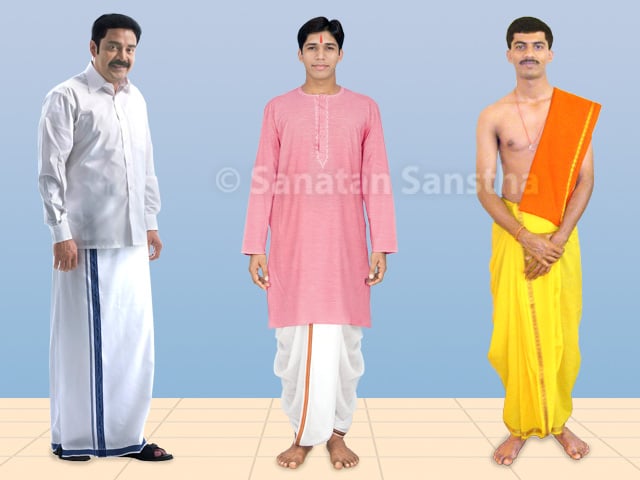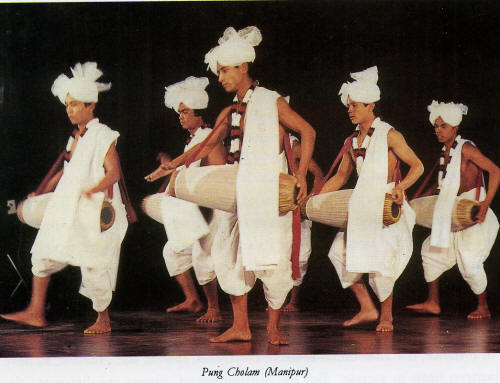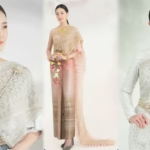Dhoti (Indian subcontinent) is not just a piece of clothing; it represents an entire cultural narrative woven into the fabric of Indian history. This traditional garment reflects the rich diversity and intricate social tapestry of the land, steeped in customs that are both ancient and evolving. Adorning the dhoti is to don a legacy that transcends generations, making it a striking symbol of identity and cultural pride.
The Historical Significance of Dhoti
The dhoti has its roots deeply embedded in the soils of the Indian subcontinent, tracing back centuries to when it was first worn as a practical garment for men. Its simplicity and elegance have allowed it to remain relevant throughout history, adapting to various cultural shifts while retaining its core significance.
Origins and Evolution
The journey of the dhoti can be traced to ancient times when it served primarily as a utilitarian garment. It was designed to suit the tropical climate of the Indian subcontinent, providing comfort and ease of movement.
Over time, the dhoti evolved from a simple cloth wrapped around the waist to a symbol of cultural dignity. Various interpretations emerged based on regional practices, leading to diverse styles and names. For instance, the veshti is an adaptation found predominantly in Southern India, signifying how local traditions can influence broader cultural symbols.
This evolution of the dhoti parallels the socio-political changes within India. During periods of colonial rule, wearing the dhoti became an act of resistance—a way for Indians to assert their national identity against foreign domination. The dhoti became synonymous with leaders such as Mahatma Gandhi, who promoted it as a representation of Indian self-reliance and simplicity.
Dhoti in Religious and Cultural Practices

In the realm of spirituality and religion, the dhoti holds a significant place. Many Hindu rituals require the wearer to don a dhoti, reflecting purity and respect in sacred spaces.
During religious ceremonies, men often wear white dhotis, symbolizing cleanliness and devotion. Picture a group of worshippers adorned in pristine dhotis, standing together in prayer, creating a sacred aura that envelops the space.
Moreover, different regions of India have unique ways of incorporating the dhoti into their traditional festivals and events, enhancing community bonding through shared cultural expressions.
Social and Economic Implications
The dhoti does more than merely serve as a garment; it serves as a social indicator reflecting one’s background, status, and even profession. In many rural communities, the way a dhoti is worn or styled can indicate economic status, marital status, and affiliations to specific social groups.
In urban settings, the perception of the dhoti is changing. Young professionals embrace this traditional attire by pairing it with contemporary clothing, thereby creating a new fashion statement that resonates with modern sensibilities.
The intricate art of weaving dhoti fabrics also supports local artisans and economies, sustaining age-old craftsmanship amidst modern consumerism. Supporting the dhoti industry means supporting livelihoods connected to this cultural emblem.
The Aesthetic Appeal of Dhoti
While the dhoti encapsulates a world of meaning and tradition, it also boasts an undeniable aesthetic appeal that captures the hearts of many.
Color and Design Variations
One of the most striking aspects of the dhoti is its vibrant colors and patterns. From plain whites to vivid hues adorned with intricate designs, each variation tells a story tied to the region and community of its origin.
The art of designing dhotis involves numerous techniques, including block printing and dyeing, which vary dramatically from one region to another. The presence of these artistic elements transforms the dhoti into a canvas, allowing wearers to express their individuality while remaining rooted in tradition.
For example, the colorful dhotis from Gujarat display bold patterns that reflect the region’s cultural vibrancy, while the simpler, understated versions from Kerala showcase elegance and subtleness, highlighting the versatility of this attire.
Modern Adaptations and Style Trends

The introduction of modern adaptations, such as dhoti pants, has gained immense popularity among younger generations. These variations maintain the essence of the original garment while offering a contemporary twist.
Fashion designers are merging traditional dhoti styles with Western silhouettes—think dhoti skirts paired with chic tops or tailored jackets. This cross-cultural blending challenges conventional fashion norms and showcases the dhoti’s adaptability in modern wardrobes.
Furthermore, celebrities and influencers have donned the dhoti at various public appearances, sparking interest and admiration among the masses. Their influence introduces the idea that the dhoti can seamlessly transition from a traditional context to high fashion, appealing to a vast audience.
Accessories and Pairing
To elevate the dhoti’s charm further, accessories play a crucial role. A well-chosen kurta or sherwani can enhance the overall look, while traditional ornaments like necklaces, turbans, or jewelry add layers of elegance.
A traditional dhoti effortlessly pairs with a vest or jacket, embodying a fusion of styles that conveys both heritage and modernity. Personal expression takes center stage when mixing various fabrics, patterns, and designs, ultimately transforming the dhoti into a statement piece.
Ultimately, the aesthetic appeal of the dhoti lies not only in its visual allure but in the stories, emotions, and identities it conveys through every fold and drape.
Dhoti in Contemporary Fashion
Today, the dhoti stands at the crossroads of tradition and modernity, marking its presence in contemporary fashion trends.
Fashion Runways and Red Carpet Moments
The inclusion of dhoti styles in fashion runways and red carpet events has marked a significant shift in how this garment is perceived. Designers are increasingly showcasing innovative designs that incorporate traditional elements, giving the dhoti a fresh and exciting perspective.
When models grace the runway in intricately designed dhotis paired with stylish blouses or jackets, they represent a harmonious blend of past and present. These creations challenge stereotypes surrounding traditional attire and invite audiences to rethink their perceptions of fashion.
Influencing Global Trends

The influence of the dhoti extends beyond Indian borders. International designers have started integrating dhoti-inspired designs into their collections, showcasing the garment’s universal appeal.
This global recognition brings forth an interesting dialogue about cultural appropriation versus appreciation. While some may argue that adopting traditional attire without understanding its context can dilute its meaning, others celebrate this exchange as a form of cultural appreciation. The dhoti’s journey onto the global stage illustrates the potential for fashion to transcend boundaries and foster dialogue across cultures.
Social Media and the Rise of Dhoti Fashion
Social media platforms like Instagram and Pinterest have become vital channels for promoting dhoti fashion. Influencers and fashion aficionados share their interpretations of the traditional garment, inspiring others to experiment with styling and pairings.
As people document their unique takes on the dhoti, the garment gains visibility, prompting discussions about its relevance in contemporary settings. The hashtag culture surrounding dhoti fashion allows individuals to engage in an ongoing conversation about tradition, identity, and self-expression.
Thus, the dhoti continues to evolve, embracing change while preserving its cultural essence, demonstrating the power of fashion as a platform for storytelling.
The Dhoti Experience: Beyond the Fabric
Wearing a dhoti is undoubtedly a physical experience, yet its resonance stretches far deeper. It connects individuals to their roots, evoking feelings of nostalgia and cultural pride that shape their identities.
The Emotional Connection
Putting on a dhoti often stirs emotions linked to family traditions and memories. For many, the dhoti embodies moments of celebration—weddings, festivals, and rituals where the garment signifies belonging and continuity.
Imagine a young man slipping into a dhoti for a wedding, feeling the weight of his cultural heritage draped around him. Each fold tells tales of his ancestors, creating a sense of connection that transcends time and space.
This emotional connection is invaluable, serving as a reminder of one’s identity in a rapidly changing world. The dhoti becomes more than clothing; it transforms into a vessel carrying the legacies of those who came before.
The Role of Community

The dhoti plays a pivotal role in communal gatherings, evoking a sense of unity among those who wear it. At weddings or festivals, the sight of friends and families clad in dhotis fosters collective identity, allowing individuals to feel part of something greater.
These gatherings illustrate how the dhoti acts as a common thread that binds communities together. Whether at a religious ceremony or a festive celebration, the act of wearing a dhoti creates a shared experience that reinforces cultural bonds.
The Dialogues of Identity
As society progresses and evolves, so do conversations surrounding identity and belonging. The dhoti serves as a focal point for these discussions, prompting questions about modernity versus tradition and individual expression versus collective identity.
Every time someone wears a dhoti, they enter into a dialogue about their cultural heritage and personal beliefs. The choices made—how to style it, what accessories to pair—communicate messages about who they are today while acknowledging where they come from.
Ultimately, the dhoti invites individuals to explore their own narratives amid the larger cultural tapestry, encouraging personal reflection while fostering community connections.
Conclusion

In embracing the dhoti, one does not merely wear a piece of fabric; they don a rich history that celebrates India’s diversity and cultural depth. More than just a timeless garment, the dhoti embodies a myriad of meanings—symbolizing resistance, identity, and emotional connections that transcend generations.
As we navigate through modernity and globalization, the dhoti’s ability to adapt while retaining its essence speaks volumes about its resilience. It is a testament to the symbiotic relationship between tradition and innovation, showing us that culture is not static, but ever-evolving.
The journey of the dhoti invites us all to participate in the narrative, celebrating the beauty of our roots while embracing the possibilities of the future. Ultimately, the dhoti is a bridge connecting us to our past, present, and future—a rich tapestry woven from the threads of identity, culture, and self-expression.
✉️ Stay Connected — Subscribe for Weekly Updates
Discover timeless stories, practical wisdom, and beautiful culture — delivered straight to your inbox.
*We only share valuable insights — no spam, ever.







Buy Backlinks
Tháng mười một 24, 2024My spouse and I stumnled over here by a different website and thought I may as well check things out.
I like what I see so now i am following you. Look forward to finding out about your web page yet again.
Buy Cheap Proxies
Tháng mười một 24, 2024magnificent points altogether, you just won a logo new reader.
What might you recommend about your submit that you made some days inn the past?
Any positive?